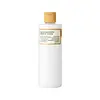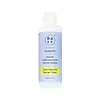What's inside
What's inside
 Key Ingredients
Key Ingredients

 Benefits
Benefits

 Concerns
Concerns

 Ingredients Side-by-side
Ingredients Side-by-side

Oryza Sativa Bran Water
MaskingGlycerin
HumectantButylene Glycol
Humectant1,2-Hexanediol
Skin ConditioningWater
Skin ConditioningDiphenyl Dimethicone
EmollientTriethylhexanoin
MaskingBetaine
HumectantPolyglyceryl-10 Myristate
Skin ConditioningHydroxyacetophenone
AntioxidantArginine
MaskingAcrylates/C10-30 Alkyl Acrylate Crosspolymer
Emulsion StabilisingPanthenol
Skin ConditioningDipotassium Glycyrrhizate
HumectantEthylhexylglycerin
Skin ConditioningGlyceryl Polymethacrylate
Sodium Hyaluronate
HumectantDisodium EDTA
Carbomer
Emulsion StabilisingMethylpropanediol
SolventPotentilla Anserina Extract
Skin ConditioningPolyquaternium-51
Skin ConditioningCynara Scolymus Leaf Extract
Skin ConditioningAvena Sativa Kernel Extract
AbrasiveHydrogenated Lecithin
EmulsifyingBeta-Glucan
Skin ConditioningCamellia Sinensis Leaf Water
MaskingLactococcus Ferment Lysate
Skin ConditioningTocopherol
AntioxidantFructooligosaccharides
HumectantCentella Asiatica Extract
CleansingCyperus Rotundus Root Extract
Skin ConditioningHydrolyzed Hyaluronic Acid
HumectantEctoin
Skin ConditioningMannitol
HumectantPapain
Skin ConditioningOryza Sativa Bran Oil
EmollientOryza Sativa Extract
AbsorbentCeramide NP
Skin ConditioningPhytosphingosine
Skin ConditioningSodium Chloride
MaskingBromelain
Skin ConditioningPropanediol
SolventOryza Sativa Lees Extract
Skin ConditioningLactobacillus/Rice Ferment
Skin ConditioningProtease
ExfoliatingSucrose Distearate
EmollientCaprylic/Capric Triglyceride
MaskingSodium Phytate
Hydroxypropyl Cyclodextrin
MaskingSodium Dna
Skin ConditioningKojic Dipalmitate
EmollientOryzanol
Skin ConditioningLipase
Skin ConditioningOryza Sativa Bran Water, Glycerin, Butylene Glycol, 1,2-Hexanediol, Water, Diphenyl Dimethicone, Triethylhexanoin, Betaine, Polyglyceryl-10 Myristate, Hydroxyacetophenone, Arginine, Acrylates/C10-30 Alkyl Acrylate Crosspolymer, Panthenol, Dipotassium Glycyrrhizate, Ethylhexylglycerin, Glyceryl Polymethacrylate, Sodium Hyaluronate, Disodium EDTA, Carbomer, Methylpropanediol, Potentilla Anserina Extract, Polyquaternium-51, Cynara Scolymus Leaf Extract, Avena Sativa Kernel Extract, Hydrogenated Lecithin, Beta-Glucan, Camellia Sinensis Leaf Water, Lactococcus Ferment Lysate, Tocopherol, Fructooligosaccharides, Centella Asiatica Extract, Cyperus Rotundus Root Extract, Hydrolyzed Hyaluronic Acid, Ectoin, Mannitol, Papain, Oryza Sativa Bran Oil, Oryza Sativa Extract, Ceramide NP, Phytosphingosine, Sodium Chloride, Bromelain, Propanediol, Oryza Sativa Lees Extract, Lactobacillus/Rice Ferment, Protease, Sucrose Distearate, Caprylic/Capric Triglyceride, Sodium Phytate, Hydroxypropyl Cyclodextrin, Sodium Dna, Kojic Dipalmitate, Oryzanol, Lipase
Water
Skin ConditioningPropanediol
SolventPentylene Glycol
Skin ConditioningDipropylene Glycol
HumectantGlycerin
HumectantDiphenyl Dimethicone
EmollientTriethylhexanoin
MaskingPanthenol
Skin ConditioningBetaine
HumectantButylene Glycol
HumectantHydroxyacetophenone
AntioxidantHydrogenated Lecithin
EmulsifyingPolyglyceryl-10 Oleate
Skin ConditioningAcrylates/C10-30 Alkyl Acrylate Crosspolymer
Emulsion StabilisingTromethamine
BufferingEthylhexylglycerin
Skin Conditioning1,2-Hexanediol
Skin ConditioningGlyceryl Polymethacrylate
Carbomer
Emulsion StabilisingCeramide NP
Skin ConditioningUlmus Davidiana Root Extract
Skin ConditioningAmaranthus Caudatus Seed Extract
Skin ConditioningMacadamia Ternifolia Seed Oil
EmollientPolyglyceryl-10 Stearate
Skin ConditioningCandida Bombicola/Glucose/Methyl Rapeseedate Ferment
AntimicrobialCentella Asiatica Extract
CleansingFicus Carica Fruit Extract
HumectantCamellia Sinensis Leaf Extract
AntimicrobialCetearyl Alcohol
EmollientSodium Stearoyl Glutamate
CleansingSqualane
EmollientSimmondsia Chinensis Seed Oil
EmollientTocopherol
AntioxidantWater, Propanediol, Pentylene Glycol, Dipropylene Glycol, Glycerin, Diphenyl Dimethicone, Triethylhexanoin, Panthenol, Betaine, Butylene Glycol, Hydroxyacetophenone, Hydrogenated Lecithin, Polyglyceryl-10 Oleate, Acrylates/C10-30 Alkyl Acrylate Crosspolymer, Tromethamine, Ethylhexylglycerin, 1,2-Hexanediol, Glyceryl Polymethacrylate, Carbomer, Ceramide NP, Ulmus Davidiana Root Extract, Amaranthus Caudatus Seed Extract, Macadamia Ternifolia Seed Oil, Polyglyceryl-10 Stearate, Candida Bombicola/Glucose/Methyl Rapeseedate Ferment, Centella Asiatica Extract, Ficus Carica Fruit Extract, Camellia Sinensis Leaf Extract, Cetearyl Alcohol, Sodium Stearoyl Glutamate, Squalane, Simmondsia Chinensis Seed Oil, Tocopherol
Ingredients Explained
These ingredients are found in both products.
Ingredients higher up in an ingredient list are typically present in a larger amount.
1,2-Hexanediol is a synthetic liquid and another multi-functional powerhouse.
It is a:
- Humectant, drawing moisture into the skin
- Emollient, helping to soften skin
- Solvent, dispersing and stabilizing formulas
- Preservative booster, enhancing the antimicrobial activity of other preservatives
Acrylates/C10-30 Alkyl Acrylate Crosspolymer is a synthetic polymer. It is used to thicken and improve the texture of products. Due to its properties, it can prevent water and oil ingredients from separating.
Betaine is a common humectant (a substance that promotes retention of moisture). It's known to be gentle on the skin and can help balance hydration.
This ingredient is best for improving hydration and soothing irritated skin. Studies also show it helps even out skin tone.
Fun fact: Betaine is naturally created in the skin and body. The kind found within cosmetic products can be either plant-derived or synthetic.
Another name for betaine is trimethylglycine.
Learn more about BetaineButylene Glycol (or BG) is used within cosmetic products for a few different reasons:
Overall, Butylene Glycol is a safe and well-rounded ingredient that works well with other ingredients.
Though this ingredient works well with most skin types, some people with sensitive skin may experience a reaction such as allergic rashes, closed comedones, or itchiness.
Learn more about Butylene GlycolCarbomer is a polymer of acrylic acid. Its main role is to create a gel consistency.
A high amount of carbomer can cause pilling or balling up of products. Don't worry, most products contain 1% or less of carbomer.
Centella Asiatica Extract (Centella) is derived from an herb native to Southeast Asia. It is famous for its anti-inflammatory and soothing properties.
Centella is rich in antioxidants and amino acids, such as Madecassic Acid and Asiaticoside.
Studies show the compounds in centella help with:
The combination of all these properties makes centella effective at soothing, hydrating, and protecting the skin.
Other great components of centella include Vitamin A, vitamin C, several B vitamins, and Asiatic Acid.
Fun fact: Centella has been used as a medicine and in food for many centuries. As a medicine, it is used to treat burns, scratches, and wounds.
Learn more about Centella Asiatica ExtractCeramide NP is a type of ceramide and formally known as ceramide 3.
Ceramides are intercellular lipids naturally found in our skin that bonds dead skin cells together to create a barrier. They are known for their ability to hold water and thus are a great ingredient for dry skin.
Ceramides are an important building block for our skin barrier. A stronger barrier helps the skin look more firm and hydrated. By bolstering the skin ceramides act as a barrier against irritating ingredients. This can help with inflammation as well.
If you would like to eat ceramides, sweet potatoes contain a small amount.
Read more about other common types of ceramides here:
Ceramide AP
Ceramide EOP
Diphenyl Dimethicone is a type of silicone.
Ethylhexylglycerin (we can't pronounce this either) is commonly used as a preservative and skin softener. It is derived from glyceryl.
You might see Ethylhexylglycerin often paired with other preservatives such as phenoxyethanol. Ethylhexylglycerin has been found to increase the effectiveness of these other preservatives.
Glycerin is already naturally found in your skin. It helps moisturize and protect your skin.
A study from 2016 found glycerin to be more effective as a humectant than AHAs and hyaluronic acid.
As a humectant, it helps the skin stay hydrated by pulling moisture to your skin. The low molecular weight of glycerin allows it to pull moisture into the deeper layers of your skin.
Hydrated skin improves your skin barrier; Your skin barrier helps protect against irritants and bacteria.
Glycerin has also been found to have antimicrobial and antiviral properties. Due to these properties, glycerin is often used in wound and burn treatments.
In cosmetics, glycerin is usually derived from plants such as soybean or palm. However, it can also be sourced from animals, such as tallow or animal fat.
This ingredient is organic, colorless, odorless, and non-toxic.
Glycerin is the name for this ingredient in American English. British English uses Glycerol/Glycerine.
Learn more about GlycerinWe don't have a description for Glyceryl Polymethacrylate yet.
Hydrogenated Lecithin is created from the hydrogenation of lecithin (a group of phospholipids). Hydrogenation is a chemical reaction between hydrogen and another element.
This ingredient is an emollient and emulsifier. As an emollient, it helps soften skin by trapping moisture within. As an emulsifier, it prevents oil and water ingredients from separating.
Hydroxyacetophenone is antioxidant with skin conditioning and soothing properties. It also boosts the efficiency of preservatives.
This ingredient is not irritating or sensitizing.
Panthenol is a common ingredient that helps hydrate and soothe the skin. It is found naturally in our skin and hair.
There are two forms of panthenol: D and L.
D-panthenol is also known as dexpanthenol. Most cosmetics use dexpanthenol or a mixture of D and L-panthenol.
Panthenol is famous due to its ability to go deeper into the skin's layers. Using this ingredient has numerous pros (and no cons):
Like hyaluronic acid, panthenol is a humectant. Humectants are able to bind and hold large amounts of water to keep skin hydrated.
This ingredient works well for wound healing. It works by increasing tissue in the wound and helps close open wounds.
Once oxidized, panthenol converts to pantothenic acid. Panthothenic acid is found in all living cells.
This ingredient is also referred to as pro-vitamin B5.
Learn more about PanthenolPropanediol is an all-star ingredient. It softens, hydrates, and smooths the skin.
It’s often used to:
Propanediol is not likely to cause sensitivity and considered safe to use. It is derived from corn or petroleum with a clear color and no scent.
Learn more about PropanediolTocopherol (also known as Vitamin E) is a common antioxidant used to help protect the skin from free-radicals and strengthen the skin barrier. It's also fat soluble - this means our skin is great at absorbing it.
Vitamin E also helps keep your natural skin lipids healthy. Your lipid skin barrier naturally consists of lipids, ceramides, and fatty acids. Vitamin E offers extra protection for your skin’s lipid barrier, keeping your skin healthy and nourished.
Another benefit is a bit of UV protection. Vitamin E helps reduce the damage caused by UVB rays. (It should not replace your sunscreen). Combining it with Vitamin C can decrease sunburned cells and hyperpigmentation after UV exposure.
You might have noticed Vitamin E + C often paired together. This is because it is great at stabilizing Vitamin C. Using the two together helps increase the effectiveness of both ingredients.
There are often claims that Vitamin E can reduce/prevent scarring, but these claims haven't been confirmed by scientific research.
Learn more about TocopherolTriethylhexanoin is created from glycerin and 2-ethylhexanoic acid. It is a solvent and emollient.
As a solvent, Triethylhexanoin helps dissolve ingredients to stable bases or help evenly distribute ingredients throughout the product.
It is also an emollient and helps condition the skin.
Learn more about TriethylhexanoinWater. It's the most common cosmetic ingredient of all. You'll usually see it at the top of ingredient lists, meaning that it makes up the largest part of the product.
So why is it so popular? Water most often acts as a solvent - this means that it helps dissolve other ingredients into the formulation.
You'll also recognize water as that liquid we all need to stay alive. If you see this, drink a glass of water. Stay hydrated!
Learn more about Water